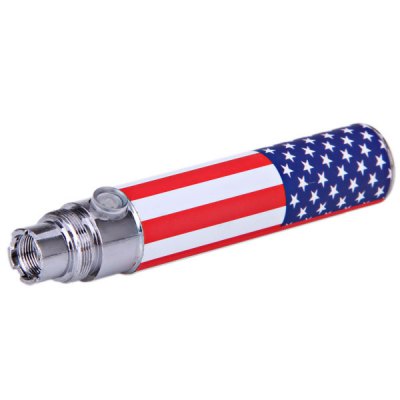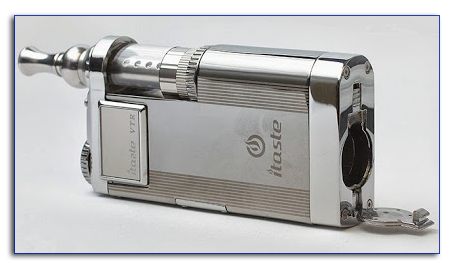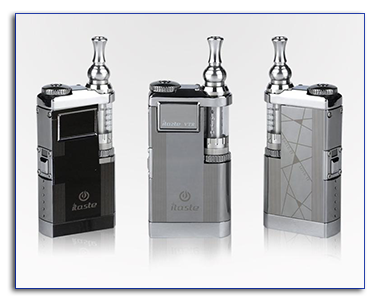Table of Contents
Introduction
Spinfuel eMagazine reviewed the Innokin iTaste VTR when it was first released to the public. Since then, there has been much written about the device. So, in order to get a fresh perspective as we close out the year our own John Castle volunteered to live with the VTR for a while and provide us with his own experience. – Ed.
 You know, when I first saw a photo of the iTaste VTR, I remember thinking that it was the third iteration of the MVP. Similar only in that it’s a “box mod”, however, the VTR is a radical departure from its older sibling in several crucial ways that go beyond the cosmetic and into the realms of ergonomics and function.
You know, when I first saw a photo of the iTaste VTR, I remember thinking that it was the third iteration of the MVP. Similar only in that it’s a “box mod”, however, the VTR is a radical departure from its older sibling in several crucial ways that go beyond the cosmetic and into the realms of ergonomics and function.
The VTR is only the second “box mod” I have used on a regular basis, the first being the aforementioned MVP (1, not 2). How does it stack up against its big brother? Read on and find out!
Before I go any further I would like to extend my personal thanks to ePuffStore for donating this device for the review. ePuffStore sells the VTR for $79.89, which I believe is the lowest price for it that I’ve seen anywhere else, by $30 or more. – John Castle
Presentation
The iTaste VTR arrived in a display box that is identical in trimmings if not in dimensions to the “gun case-like” display box of the iTaste 134. A simple swing-clasp allowed access to the goodies inside, which were the device itself, an Innokin iClear 30S, and an extension/adapter tube, each of them cradled lovingly in soft black foam under a very slickly produced instruction manual sporting thick, silver-trimmed black paper covers.
Build Quality
The build quality on the iTaste VTR is as solid and competent as one could wish for with an APV at its price point; (normally more than $110) the ergonomics, on the other hand, give rise to a few minor nitpicks from me.
The first of these is the weight. It’s not uncomfortable, but neither is it exactly inviting, and it has yet to make its way into my coat pocket for a second outing on the town.
Now let me balance that with a design/ergonomic touch I did find comfortable and most welcome; the “back” edge of the device, the part that rests in the web between thumb and fingers, is rounded. The downside? The opposite side, where the firing button is located, is not. For those with smaller hands than mine, that shouldn’t be a problem. Simple fact is, though, that hands come in all sizes, so this shape won’t be comfortable for everyone.
My only other minor worry, with regard to the build quality of the VTR, is the battery compartment door. It seems worryingly breakable, and I find myself exercising extreme caution just operating the catch mechanism for it. I’m sure that it should be fine for a good, long useable lifespan — but it does feel like the least sturdy component on the device.
Features
The iTaste VTR features a recessed 510-connection which is compatible with most 2.5ml to 3ml capacity clearomizers, as well as being compatible with (if not necessarily attractive with) 510 XL cartomizers. However, the integrated connection threads are not compatible with recessed-connection devices such as the Protank Mini (any generation), SMOKTech XXL Cartomizers (the big fat ones with the black rubber mouthpieces), the Innokin iClear 16, et cetera.
For devices such as those, you will need to use the included adapter/extension accessory, a long black tube which fills the recessed area, including the enclosed, circular upper “bracket” which reinforces the top part of compatible clearomizers.
The adapter/extender tube not only allows a smaller AD to sit above and therefore outside of the restrictive “bracket”, it also features full 510/eGo thread compatibility, allowing you to employ a much wider array of ADs than the integrated connection threads. However, take note: this comes at the cost of added overall size and a slight unbalancing of the overall device in the hand. Not that it will make the device feel “top heavy” — slim chance of that — but it can shift the overall feel of the VTR from “heavy but compact” to outright “unwieldy.”
 The next feature I want to discuss is the variable voltage/variable wattage feature. This is one of the better-executed features of this device, and coming from Innokin’s fairly long history of including this ability in its devices, it should be no surprise that I find they’ve done a serviceable job of it here.
The next feature I want to discuss is the variable voltage/variable wattage feature. This is one of the better-executed features of this device, and coming from Innokin’s fairly long history of including this ability in its devices, it should be no surprise that I find they’ve done a serviceable job of it here.
Atop the button-side edge of the iTaste VTR there sits a knurled wheel. On top and dead center of that wheel there is a single button. Pressing that button, once the device is turned on via the usual three-click activation sequence, will light the display with a reading of the attached AD’s resistance. And there we run into an issue — but one we’ll set aside for just a moment.
After a second, the resistance reading winks out and is replaced by either the voltage or power setting, depending on which one the user has selected. The default is voltage adjustment. At this point, the user may increase the voltage by rotating the wheel clockwise; alternately, the user may decrease the voltage by rotating the wheel counterclockwise.
To switch from voltage mode to wattage mode, the user would press the button once; after the resistance reading has been replaced by the voltage output, the user would simply click the button again to switch from voltage to wattage, and adjust the wheel to taste.
Switching from wattage back to voltage merely involves repeating the above process.
I do have one minor complaint, and then we’ll get to the good stuff, I promise.
My complaint is regarding the iTaste VTR’s adjustment scheme. There are tactile detents in the adjustment wheel; this is a good thing. It means that I can set my wattage level where I want it, and an errant brush of whatever isn’t going to adjust my setting when I don’t want it to.
However, those tactile stops in the wheel’s rotation don’t actually match anything. I’ll give you an example for contrast: the wattage adjustment wheel on the Innokin Cool Fire 2. Each tactile stop on the adjustment wheel for the Cool Fire 2 is marked with the wattage that corresponds to that stop.
Now, I will grant this: It certainly may be that the markings on the Cool Fire 2’s wheel are not 100% digital-accurate. And it’s not as though the adjustment wheel on the VTR would be more accurate if this complaint were addressed. It’s simply… disconcerting to adjust to 8.5 watts perfectly, and when the wheel finally sinks into its next stop, the number jumps to 9. Dial it back 2 stops, it’s still 9, and only on the 3rd stop adjusted back does it return to 8.5. It simply gives a very loose and inaccurate feel where one expects anything but.
…Now, as promised, to the good stuff.
First, the sheer range of power output adjustment is wild. From 3 watts to 15 watts, I don’t think I’ve seen a device that offers a wider range of power output than the VTR. Now I, personally, have never vaped a damn thing at 15 watts, and I can’t fathom the coming of the day when I ever will — but that’s just me.
Maybe for the High-Resistance vaping crowd out there — and though I’ve never encountered a member of such a group, I can certainly imagine that there are more than a few — 15 watts might be just the ticket. And if that’s you, well, the VTR has got you covered.
Let me tell you a little bit about my real world usage, performance discoveries, and so forth.
Real-world Use
In real world use, the VTR really is a treat — not flawless, but certainly highly enjoyable. My first day with the VTR, after charging up my 18650 battery and inserting it into the device, I took a minor bit of a hike down to the corner store, happily vaping away with the Kanger Aero Tank, which was filled with Mountain Oak Vapors’ “Sunday Morning.”
The iTaste VTR and the Kanger Aero Tank are simply made for each other — perhaps not in the literal way that the VTR and the iClear 30S are made for each other, of course, but the fit between this APV and the Aero is simply phenomenal.
And the performance achieved with that marriage of devices is just mind-blowing. Well, frankly, the coupling of the VTR and either the Aero Tank, the iClear 30S, or anything else provides wonderful performance.
One other note — and this applies to a couple of Innokin APVs I have sitting on my desk right now, both the VTR and the Cool Fire II — the efficiency of battery usage with this latest batch of Innokin APVs seems to have noticeably improved.
I get two-and-a-half to three full days of use out of the VTR with a single fully charged 2000mAh 18650 battery. The Cool Fire 2 gives me a full day to a day-and-a-half of use from a single 800mAh 18350. I’ve been using the VTR a little more lightly than I normally would, granted, but I’m on Day Three of my most recent battery charge, and the power level is still showing green.
But now we come to the big question…
Recommendation
Would I recommend the iTaste VTR? The answer to that is a qualified Yes. Here are the qualifications:
If you don’t mind — or even prefer — a device with a whole lot of heft to it…
If you don’t mind — or even prefer — using 2.5-3ml tank style clearomizers with 510 connections as your primary ADs…
Then, yes, the iTaste VTR is right up your alley. Now, let me give you a word of complete frankness from my own personal experience. Between the VTR and the Cool Fire II sitting on my desk, I personally find myself reaching for the Cool Fire II much more frequently than I reach for the VTR. The smaller device doesn’t feature resistance checking at all; it’s all wattage, all the time. However, it’s just, well… smaller. Lighter. More comfortable. And the connection is less restrictive.
But whichever device you choose, it’s my opinion that Innokin is leading the pack on innovation and performance as we leave 2013 behind. I can’t wait to see what 2014 brings.
John Castle





